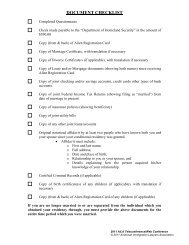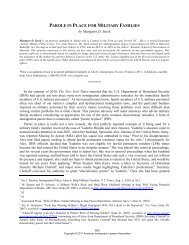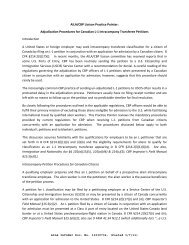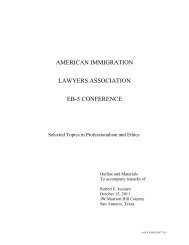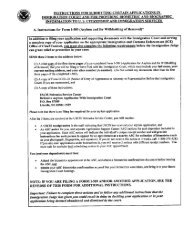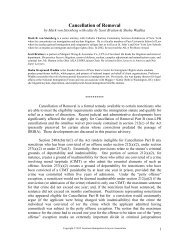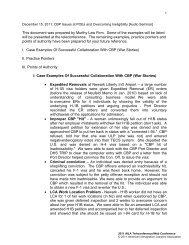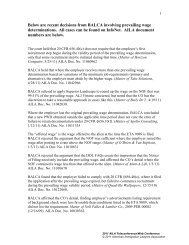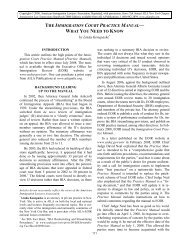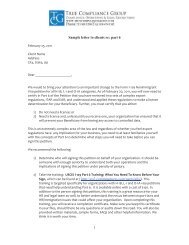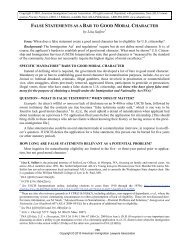Resources for 8-24-11 Seminar - AILA webCLE
Resources for 8-24-11 Seminar - AILA webCLE
Resources for 8-24-11 Seminar - AILA webCLE
Create successful ePaper yourself
Turn your PDF publications into a flip-book with our unique Google optimized e-Paper software.
2. Put together a package of materials to support your request <strong>for</strong>prosecutorial discretion. To better make a record, make your requestin writing. Consider providing a detailed cover letter or brief,supported by material that will demonstrate that your client isdeserving of prosecutorial discretion. Include all the facts that animmigration officer will need to make an in<strong>for</strong>med decision, but be asconcise as possible.3. Use the agency memoranda to support your request. The exerciseof favorable prosecutorial discretion is not mandatory in anycircumstance. However, the memoranda do provide authority <strong>for</strong> anofficer and/or local office to act favorably. For example, where a clientin removal proceedings has an adjustment application pending be<strong>for</strong>eUSCIS (because, e.g., she is an “arriving alien” and only USCIS hasjurisdiction over the application), argue that the removal case should beterminated pursuant to the August 20, 2010 Morton memo. See JohnMorton, Assistant Secretary, ICE, “Civil En<strong>for</strong>cement: Priorities <strong>for</strong> theApprehension, Detention, and Removal of Aliens” (June 2010).Another example is found in the Howard memo, which contains thefollowing advice to local ICE counsel: "[w]here a motion to reopen <strong>for</strong>adjustment of status or cancellation of removal is filed on behalf of analien with substantial equities, no serious criminal or immigrationviolations, and who is eligible to be granted the relief except that themotion is beyond the 90-day limitation contained in 8 C.F.R. §1002.23, strongly consider exercising prosecutorial discretion."William Howard, Principal Legal Advisor, ICE, “ProsecutorialDiscretion” (Oct. <strong>24</strong>, 2005) (emphasis added). The 20<strong>11</strong> Mortonmemoranda contain similarly strong directives.4. Highlight the positive factors in your client’s case. Review thecriteria supporting favorable action that are listed in the relevantmemos and highlight the applicable criteria <strong>for</strong> the officer. Where aclient falls within a classification deserving “particular care,” be sure toemphasize and build upon this fact. Morton, “Exercising ProsecutorialDiscretion,” at 5. Develop other favorable equities, just as you wouldin a case seeking a discretionary benefit or relief from removal fromDHS.5. Address any problems or inadequacies in the case or the evidence.It is better to address such problems directly because otherwise it couldappear that you were trying to hide in<strong>for</strong>mation from the officer, whichcould undercut the credibility of your other arguments. Moreover,when there is negative in<strong>for</strong>mation, you should not only disclose it, butalso provide mitigating in<strong>for</strong>mation. For example, when there is aconviction, provide evidence of completion of probation or parole.12



